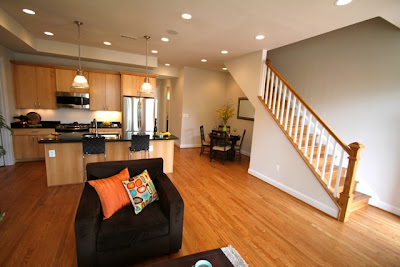
About 18 months ago, Prince George's County approved the amended Mount Rainier
Mixed-Use Town Center Zone Development Plan to guide the city toward greater development and prosperity focused on the area of Rhode Island Avenue and 34th Street,
a bid to reshape the city's urban heart and stimulate economic expansion in the historic commercial core.
"We haven’t seen a lot of changes yet," Mount Rainier City Manager
Jeannelle Wallace said. "But we will, probably, in the next few months."
The City purchased land for re- development, continued a grant program, repurposed a vacant lot and will support the upcoming
Citizen Paint Project.
Wallace said the City understood its importance as a gateway between the
District and Maryland and purchased the former funeral home and a
former liquor store in an effort to generate a new development.
"We
wanted to have an impact," she said. "And you can’t do that when you
have other people who own the property and control the development. So
now we do."
The old funeral home sits empty at the intersection of Eastern and Rhode Island avenues, greeting traffic into and out of the District. The City put it
out to bid for redevelopment with at least eight companies expressing interest in the project. Proposals now are due by May 30.
Wallace said the City would like to see a 3- or 4-story mixed-use building with retail on the ground floor, residences and office space on upper levels, and some form of onsite parking. But other plans for the site also will be considered -- the height and uses are not set in stone.
"Primarily we’re looking for something that will increase pedestrian traffic along that corridor," Wallace said, adding that contributing to the arts district and incorporating green features also would be nice.
Nisey Baylor, president of the
Mount Rainier Business Association and owner of
Nisey’s Boutique, said the group has not formally pushed for any one use at the site. But she said there is a real interest in bringing more retail to the city.
“People are always going to spend money,” she said. “It’s never going to stop. I see that. I feel that. I know that. We want businesses in Mount Rainier. We welcome and try very hard to work with businesses … to help them succeed.”
An RFP for the former liquor store has not yet been issued. But another vacant property already has a new life as a “kiss and ride” lot near City Hall. Wallace said the City purchased the lot for about $145,000 from a hopeful owner who was unable to acquire enough adjacent property for development. The new lot contributes to the bigger plan to improve public transportation, bicycle use and pedestrian traffic in the area.
While the city’s efforts are a step in the right direction, and the business association is working to attract new businesses, it has not been enough to realize the full vision of the development plan. “The vision is beautiful,” Wallace said. “But whether or not it’s cost effective or even feasible at this point is another thing.”
The plan talks about widening sidewalks, increasing bicycle access, burying utility lines … – all things that require money and work. Wallace said some of the bigger changes will only come with significant development. With the real estate market still in recovery, big development has been hard to find.
But the city and residents seem committed to making the smaller steps toward change.
Wallace said the city recently received paperwork with a new agreement and funding extension that allots $125,000 to the
Facade Improvement Program.
Gateway Community Development Corporation (Gateway CDC) previously managed the program, funded by the
Maryland Department of Housing and Community Development, but the city took over last summer. Initial funding expired in December, prompting the extension request.
And based on Baylor’s experience, changing the façade can make a huge difference. She recently utilized available grant funds to help offset costs for redoing her storefront. Simply updating her storefront, she said, encouraged people passing through to stop and look around. She encourages other businesses to do the same. "When one customer stops in they see everybody,” she said. “That’s why everybody needs to do something.”
The community will join forces to liven-up one key property. The funeral home destined for redevelopment is the site of the April 28 Citizen Paint Project led by Gateway CDC and
Joe's Movement Emporium.
"In the interim between it being demolished and now, since we are an arts district, the community has gotten together and we're going to paint the entire building," said
Michael Gumpert, Executive Director of Gateway CDC. "First we’re going to clean it, then we’re going to white wash it, then an artist is going to design a mural and the community will paint it in."
The paint will be temporary, but organizers and community leaders hope the enthusiasm for improving the City will help push them closer to the vision in the Town Center Development Plan.
“I am hoping that with each year, something more and more has happened,” Baylor said. “I really believe in the very near future that we’ll see lots more of the architectural change. I really believe all these plans will come in the next 3 to 4 years.
“But we just gotta wait it out. And you gotta be a part of it.”
Mount Rainier, Maryland, real estate development news


















































